Langmeil Lutheran Thanksgiving Church
Charles Street, Tanunda
B 1950 J.E. Dodd & Sons Gunstar Organ Works. 2m, 21spst, 9c, el.pn & el.mag.
Enl 1985 George Stephens. 2m, 23spst, 9c, el.pn & el.mag.
Gt: 8.8.8.8.4.4.2.II. Sw: 16.8.8.8.8.8.4.4.2.8. Ped: 16.16.8.8.8.
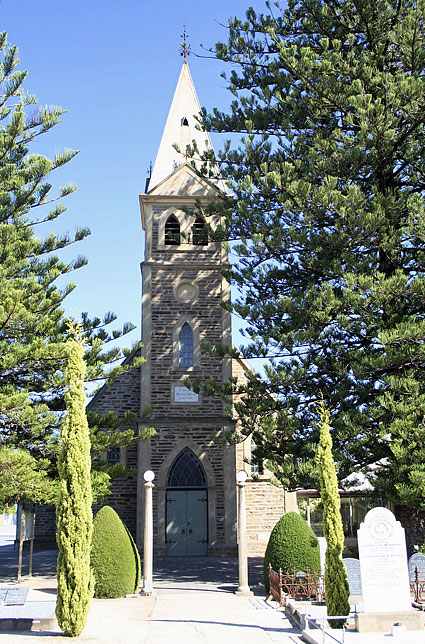
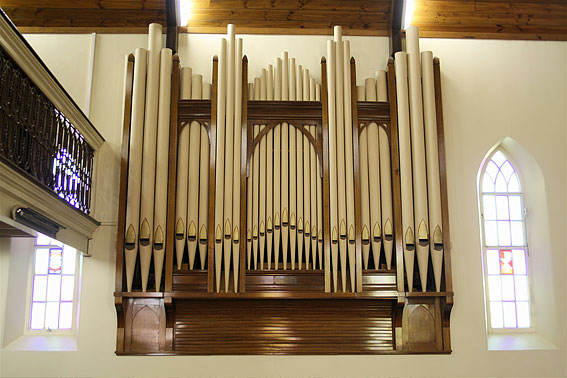
From
the 2009 OHTA Conference Book,
David Shield writes:
The
settlement of Langmeil, on the banks of the River Para, began in 1842. Pastor Kavel ministered to the
congregation, and the first church was built in 1846. Many smaller congregations emanated from this ‘mother church’. It is somewhat surprising that no pipe
organ was used until the 20th century.
The present building was constructed in 1888. The congregation, with a strong choral tradition, maintained
the use of reed organs until the pipe organ was purchased in 1950.
Early
in the piece, the congregation obtained a reed organ. It is recorded that the members of Gnadenfrei congregation
at Marananga, then affiliated with Langmeil, were “billed to a 7/- per member
levy for the Langmeil organ” circa. 1854.1 The organ was procured in 1856 at a total cost of £77.2 However, it is possibly due to the
parlous state of the church school in 1873 that Langmeil developed a strong
choral tradition. Debt on the
school, low numbers and no teacher saw a call to August C.F. Geyer of Rosenthal
which was accepted. Being musical
and a lover of religious song he also became organist with the resignation of
the incumbent Gottfr. Auchricht.
The school was not well supported by the congregation and became a
private affair continuing under Geyer and later his daughter until 1911 when it
reverted to a congregational school once again. In the meantime, Geyer established the church choir. Early attempts were less than
successful but in 1885 a set of binding rules and 1/- levy were instituted to
create a more stable situation.3
The
old church, dedicated in December 1846 and since demolished, had an iron roof
with no capping but a three inch overlap against the westerly weather, proving
to be no obstacle to rain from the east.
There was no ceiling with the exception of a small structure, for
acoustics, above pulpit and altar.
These were located central to two windows on the opposite side of the
building where there were also two entrance doors with porches. A powerful harmonium was placed on a
platform immediately inside the right entrance door. Stone flags formed the floor. The bell was hung in a tree,
later mounted near the school, and eventually sent to Bethesda Mission Station.4
In
1888, coinciding with the 50th Jubilee of the Lutheran Church in Australia, the
current church, a church of Thanksgiving, was opened on 25 November. In preparation for the new tower, the
bronze bell was cast at the Barwell foundry, Birmingham, England in 1887. Its Tone is C Sharp and it measures 30
x 24 in. (750mm) with a weight of 267 kg.5 The church is attractively sited in a large churchyard and
an avenue of Norfolk Island pine trees leads to the main entrance.
In
1899, on 8 January, a new reed organ was dedicated. Collection had been in progress for many years and the
ultimate cost was £117.6 Possibly acting on his own initiative,
Theo Geyer suggested the church acquire a pipe organ to celebrate the 25th
anniversary of the Thanksgiving church in November1913. Dodd sent him three specifications for
two-manual and pedal organs to be placed in the gallery.7
He was not successful, the congregation rejecting his
proposal. After Geyer communicated
his failure, Dodd commiserated with him.
“I am sorry that the
Congregation of your Church do not at present, see eye to eye with you, in
reference to the proposed new organ, but possibly with a little further
educating on the matter they may view matters differently.”8 Geyer died in 1946. The organ was to be a notable event of
1950, “realising the dreams and hopes of the congregation.”9
The
organ was dedicated to the memory of
Theodor J.S. Geyer, Langmeil organist from 1895 to 1946, at the morning
service of 9 April 1950. This organ is a much later example of the Dodd
firm’s work and was completed only two years before his death. To house it, a special organ
chamber of stone work matching that of the church, had been erected on the
south side of the church. The
dedication was celebrated in the afternoon with a sacred concert featuring Mr
Harold Wylde FRCO of the Elder Conservatorium assisted by Mrs Hazel Mader and
the Choir.10 The organ
became sufficiently highly regarded for the first school for organists and
choirmasters conducted by the SA District of the UELCA. to be held at Langmeil
10 years later in October 1960.11
J.E. Dodd & Sons Gunstar Organ Works 1950
2 manuals, 21 speaking stops, electro-magnetic
action
enlarged George Stephens Pty Ltd 1985 - 23 speaking stops
|
GREAT ORGAN |
|
|
|
Open Diapason |
8 |
|
|
Stopped Diapason |
8 |
|
|
Lieblich Gedact |
8 |
B |
|
Dulciana |
8 |
A |
|
Principal |
4 |
|
|
Dulcet |
4 |
A |
|
Fifteenth |
2 |
|
|
Mixture |
II |
|
|
Great Sub |
|
|
|
Great Super |
|
|
|
Swell to Great Sub |
|
|
|
Swell to Great |
|
|
|
Swell to Great Super |
|
|
|
|
|
|
|
SWELL ORGAN |
|
|
|
Lieblich Bourdon |
16 |
B |
|
Melodic Diapason |
8 |
C |
|
Hohl Flute |
8 |
|
|
Lieblich Gedact |
8 |
B |
|
Viol d’Orchestre |
8 |
|
|
Celeste |
8 |
TC |
|
Octave Diapason |
4 |
C |
|
Lieblich Flute |
4 |
|
|
Piccolo |
2 |
B |
|
Oboe |
8 |
|
|
Tremulant |
|
|
|
Swell Sub |
|
|
|
Swell Super |
|
|
|
|
|
|
|
PEDAL ORGAN |
|
|
|
Sub Bass |
16 |
D |
|
Lieblich Bourdon |
16 |
B |
|
Bass Flute |
8 |
D |
|
Gedact |
8 |
B |
|
Dolce |
8 |
A |
|
Great to Pedal |
|
|
|
Swell to Pedal |
|
|
Compass: 61/30
Detached stopkey console (located in rear gallery)
3 thumb pistons to Great (duplicated by toe
pistons)
3 thumb pistons to Swell (duplicated by toe
pistons)
Reversible toe piston for Great to Pedal
Balanced swell pedal
Location: chamber on southern wall of nave
_________________________________________________________________________
1 Wilsch, Con F., Marananga : Our
History and Heritage (1986), p.17
2 Langmeil
Congregation 100 years History 1843-1943, p.8
3 Ibid., pp.28-29
4 Ibid., p.8; Pamphlet Langmeil
Church Choir: a History (c.1999),
p.6
5 Langmeil
Congregation 100 years History 1843-1943, pp.15-16; Bagot, H., ‘Bells
of the Barossa’, Journal of Friends of Lutheran Archives, no.10 (October 2000), pp.9-16
6 Langmeil
Congregation 100 years History 1843-1943, p.17
7 Dodd to Geyer covering letter specifications and details of
construction, 26 December 1913: DLB 1913-16, pp. 231-233
8 Dodd to Geyer 9 February 1914, DLB 1913-16, p.53
9
Leske, L.H., Langmeil Congregation 1843-1968 (1968), p.30
10 Barossa and Light Herald 6 April 1950, p. 9.4; Opening and Dedication
Brochure 9 April 1950
11 Leske, op.cit., p.30
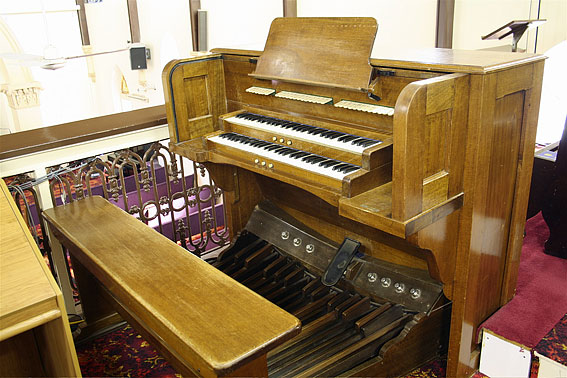




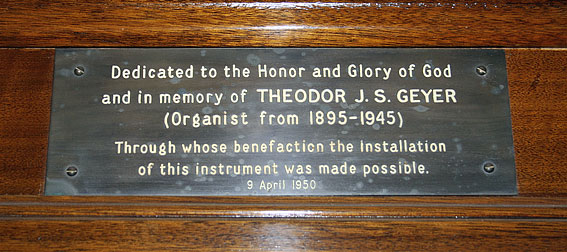
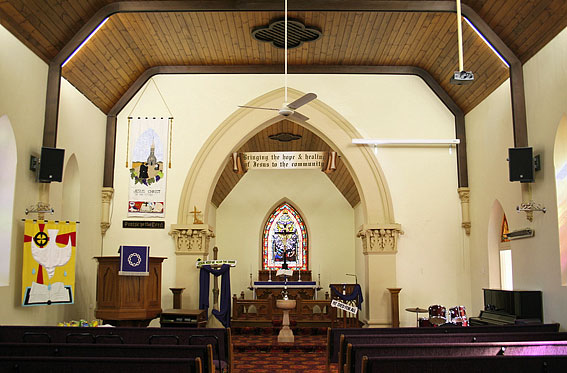
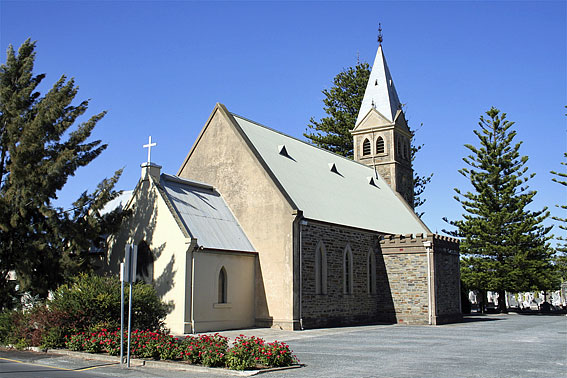
Photos: Trevor Bunning (March 2009)